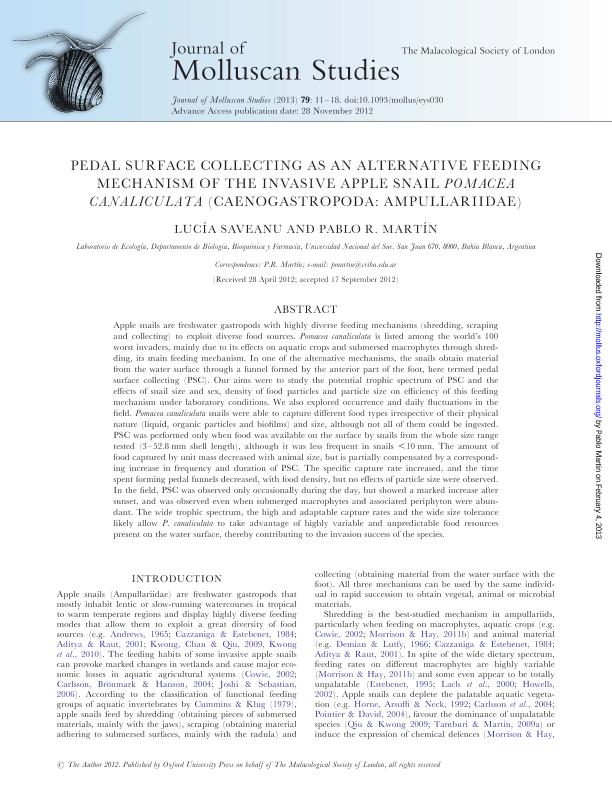Mostrar el registro sencillo del ítem
dc.contributor.author
Saveanu, Lucía

dc.contributor.author
Martín, Pablo Rafael

dc.date.available
2016-09-05T19:54:54Z
dc.date.issued
2013-01
dc.identifier.citation
Saveanu, Lucía; Martín, Pablo Rafael; Pedal surface collecting as an alternative feeding mechanism of the invasive apple snail Pomacea canaliculata (Caenogastropoda: Ampullariidae); Oxford University Press; Journal Of Molluscan Studies; 79; 1; 1-2013; 11-18
dc.identifier.issn
0260-1230
dc.identifier.uri
http://hdl.handle.net/11336/7458
dc.description.abstract
Apple snails are freshwater gastropods with highly diverse feeding mechanisms (shredding, scraping and collecting) to exploit diverse food sources. Pomacea canaliculata is listed among the world´s 100 worst invaders, mainly due to its effects on aquatic crops and submersed macrophytes through shredding, its main feeding mechanism. In one of the alternative mechanisms, the snails obtain material from the water surface through a funnel formed by the anterior part of the foot, here termed pedal surface collecting (PSC). Our aims were to study the potential trophic spectrum of PSC and the effects of snail size and sex, density of food particles and particle size on efficiency of this feeding mechanism under laboratory conditions. We also explored occurrence and daily fluctuations in the field. Pomacea canaliculata snails were able to capture different food types irrespective of their physical nature (liquid, organic particles and biofilms) and size, although not all of them could be ingested. PSC was performed only when food was available on the surface by snails from the whole size range tested (3?52.8 mm shell length), although it was less frequent in snails <10 mm. The amount of food captured by unit mass decreased with animal size, but is partially compensated by a corresponding increase in frequency and duration of PSC. The specific capture rate increased, and the time spent forming pedal funnels decreased, with food density, but no effects of particle size were observed. In the field, PSC was observed only occasionally during the day, but showed a marked increase after sunset, and was observed even when submerged macrophytes and associated periphyton were abundant. The wide trophic spectrum, the high and adaptable capture rates and the wide size tolerance likely allow P. canaliculata to take advantage of highly variable and unpredictable food resources present on the water surface, thereby contributing to the invasion success of the species.
dc.format
application/pdf
dc.language.iso
eng
dc.publisher
Oxford University Press

dc.rights
info:eu-repo/semantics/openAccess
dc.rights.uri
https://creativecommons.org/licenses/by-nc-sa/2.5/ar/
dc.subject
Pedal Surface Collecting
dc.subject
Pomacea
dc.subject
Feeding
dc.subject.classification
Ecología

dc.subject.classification
Ciencias Biológicas

dc.subject.classification
CIENCIAS NATURALES Y EXACTAS

dc.title
Pedal surface collecting as an alternative feeding mechanism of the invasive apple snail Pomacea canaliculata (Caenogastropoda: Ampullariidae)
dc.type
info:eu-repo/semantics/article
dc.type
info:ar-repo/semantics/artículo
dc.type
info:eu-repo/semantics/publishedVersion
dc.date.updated
2016-05-10T14:35:05Z
dc.journal.volume
79
dc.journal.number
1
dc.journal.pagination
11-18
dc.journal.pais
Reino Unido

dc.journal.ciudad
Oxford
dc.description.fil
Fil: Saveanu, Lucía. Universidad Nacional del Sur. Departamento de Biologia, Bioquimica y Farmacia. Laboratorio de Ecologia; Argentina. Consejo Nacional de Investigaciones Científicas y Técnicas. Centro Científico Tecnológico Bahia Blanca; Argentina
dc.description.fil
Fil: Martín, Pablo Rafael. Universidad Nacional del Sur. Departamento de Biologia, Bioquimica y Farmacia. Laboratorio de Ecologia; Argentina. Consejo Nacional de Investigaciones Científicas y Técnicas. Centro Científico Tecnológico Bahia Blanca; Argentina
dc.journal.title
Journal Of Molluscan Studies

dc.relation.alternativeid
info:eu-repo/semantics/altIdentifier/url/http://mollus.oxfordjournals.org/content/79/1/11.abstract
dc.relation.alternativeid
info:eu-repo/semantics/altIdentifier/doi/http://dx.doi.org/10.1093/mollus/eys030
Archivos asociados
